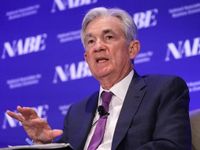It’s been a wild ride for U.S. banks and investors this October, as Wall Street weathered a storm of volatility, shifting trade rhetoric, and mounting concerns over the health of regional lenders. The past week, ending October 17, 2025, saw the S&P 500 notch its best performance since early August, rising 0.6% alongside the Dow Jones Industrial Average and the Nasdaq composite, both up by the same margin, according to the Associated Press. But beneath this upbeat headline, a deeper story of risk, resilience, and recalibration is playing out across the financial sector.
Much of the week’s market optimism was fueled by a combination of stronger-than-expected bank earnings and a sudden softening in tone from President Donald Trump on U.S.-China trade. After a jarring announcement on October 10 that threatened 100% tariffs on Chinese products, Trump quickly reassured markets, saying the tariffs were "not sustainable" and promising to meet with China’s leader Xi Jinping at an upcoming conference in South Korea. This reversal helped ease investor nerves, with Wall Street rebounding early in the week, as reported by Benzinga and the Associated Press.
Banking stocks, in particular, benefited from this improved sentiment. Major U.S. banks such as JPMorgan Chase, Goldman Sachs, Bank of America, Citigroup, Wells Fargo, and Morgan Stanley all beat analyst estimates in their latest earnings reports, highlighting the resilience of the country’s financial giants. According to Benzinga, these results underscored a pickup in investment banking and more robust corporate activity, which gave the sector a much-needed lift.
Yet, even as the big players celebrated, cracks were beginning to show among smaller regional lenders. On October 16, several regional banks flagged credit problems that rattled the industry. Zions Bancorporation announced a $50 million charge-off in the third quarter, tied to two troubled commercial and industrial loans at its California Bank & Trust unit. Western Alliance Bancorp, meanwhile, revealed it had filed a lawsuit against a borrower over allegations of fraud. Shares of both banks plunged by double digits that day, with Zions losing 13.1% and Western Alliance falling 10.8%, before recovering slightly the next day—Zions adding 5% and Western Alliance 2%, as noted by the Associated Press and Benzinga.
This bout of volatility also hit Hope Bancorp, a regional lender whose share price has pulled back roughly 15% year-to-date as of October 19, 2025. Over the past year, total shareholder return for Hope Bancorp is down nearly 19%, according to Simply Wall St. Despite these setbacks, Hope Bancorp closed at $10.23 with a fair value estimate of $12.25, indicating it is approximately 16.5% undervalued as of October 18, 2025. The company’s ongoing investments in digital platform enhancements and fintech partnerships are aimed at improving operational efficiency and customer retention—a strategy that many analysts believe could translate into sustainably lower costs and improved net margins over time.
Still, there are real risks on the horizon. Hope Bancorp’s heavy concentration in commercial real estate loans and rising integration costs threaten both earnings stability and the potential for long-term growth. These concerns mirror broader anxieties across the banking industry, especially as scrutiny intensifies on loan quality following high-profile bankruptcies such as First Brands Group, an auto parts supplier, and Tricolor Holdings, a subprime auto lender. JPMorgan Chase CEO Jamie Dimon didn’t mince words on an earnings call earlier in the week, warning, “When you see one cockroach, there are probably more. Everyone should be forewarned on this one.”
But not everyone is convinced that the sector is facing systemic trouble. Brian Jacobsen, chief economist at Annex Wealth Management, offered a more reassuring perspective to the Associated Press: “Based on earnings and data so far, it looks like this isn’t an infestation and that the potential canary in the coal mine is probably passed out and not dead.” In other words, while there are warning signs, the overall capital position of banks remains strong enough to absorb shocks—at least for now.
Adding another layer of complexity to the outlook, Federal Reserve Chair Jerome Powell weighed in on October 18, warning of mounting risks to employment and signaling that the central bank is likely to continue easing borrowing costs. This dovish stance has bolstered bets on a rate cut later in the month, which could provide further support to banks and borrowers alike. As the Associated Press noted, Treasury yields steadied after a sharp slide, with the 10-year yield edging up to 4.00% by October 17.
Meanwhile, gold continued its meteoric rise, reaching a record high of $4,350 per ounce—up more than 60% since the start of the year, marking its strongest performance since 1979, according to Benzinga. The rally in gold and gold-mining stocks has been driven by a combination of safe-haven demand, expectations for lower interest rates, and concerns over ballooning government debt in the U.S. and abroad. Even after a 2.1% pullback to $4,213.30 per ounce on October 17, gold remains one of the year’s standout performers.
The week also brought a measure of relief to the auto sector. Shares of GM, Ford, and Stellantis rebounded from recent losses, up around 6%, 4.3%, and 6.2% respectively by October 18, buoyed by improved trade and interest-rate sentiment. Both GM and Ford are set to report quarterly earnings on October 21 and 23, respectively, with investors eager to see if the positive momentum can be sustained.
Internationally, the mood was less upbeat. Stock markets tumbled across much of Europe and Asia after Wall Street’s earlier weakness. Germany’s DAX dropped 1.8%, and Hong Kong’s Hang Seng fell 2.5%, underscoring the global ripple effects of U.S. market swings and ongoing trade uncertainty.
For investors, the message is clear: volatility is here to stay, but so too is opportunity. Whether it’s the potential undervaluation of regional banks like Hope Bancorp, the resilience of financial giants, or the flight to gold amid uncertainty, the current environment demands both caution and curiosity. As Simply Wall St reminds readers, “Valuation is complex, but we’re here to simplify it.” With markets at a crossroads and central banks poised to act, the coming weeks could prove pivotal for the financial sector and beyond.
Against this backdrop of shifting sentiment and persistent risks, investors and analysts alike are left to ponder: Are these just isolated hiccups, or signs of something more fundamental? One thing’s for sure—Wall Street will be watching every twist and turn.




